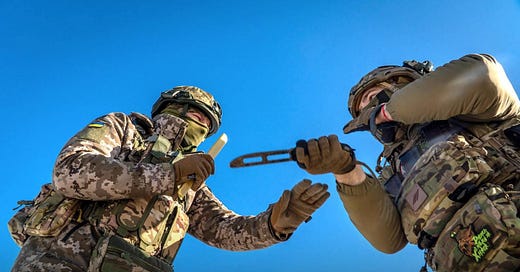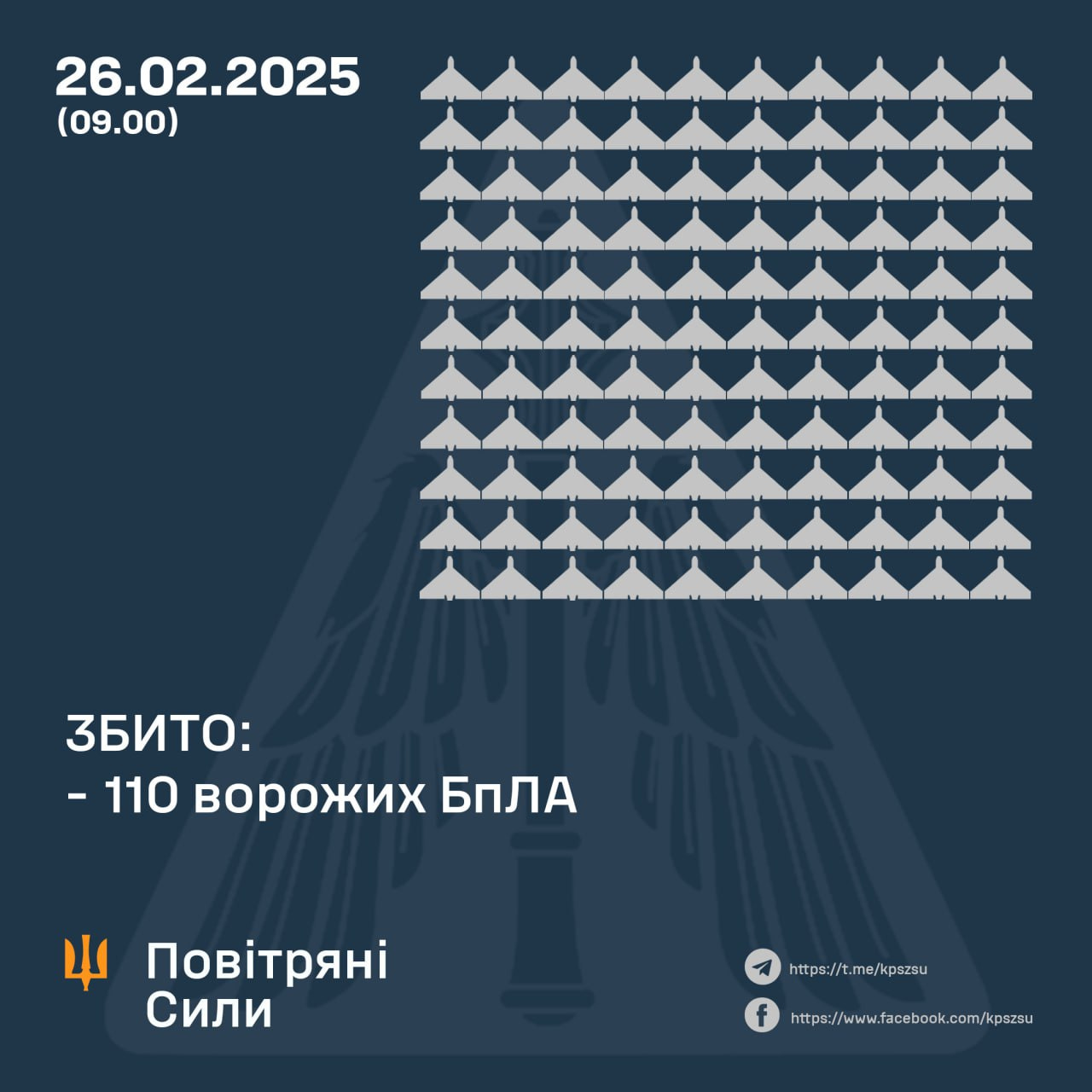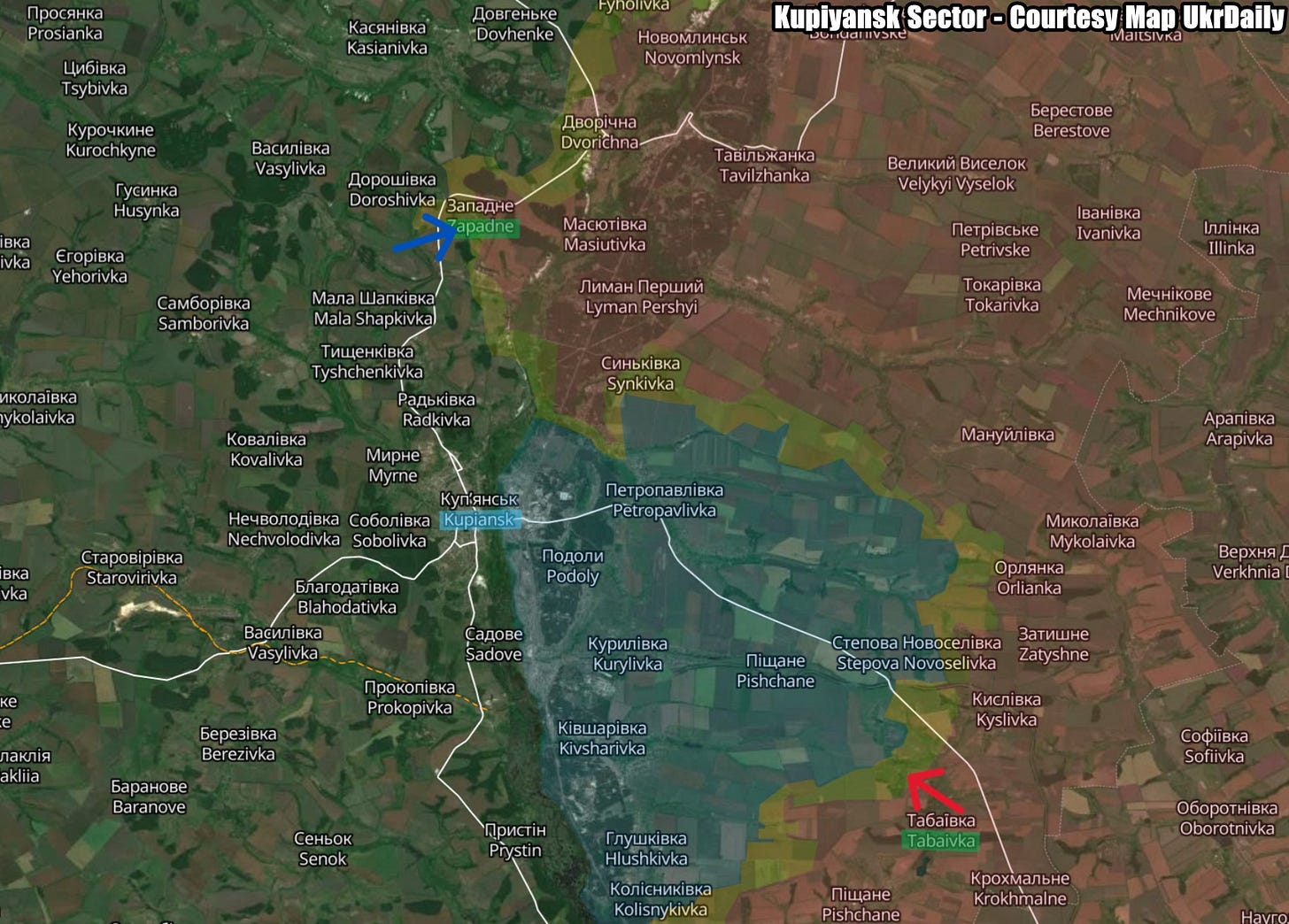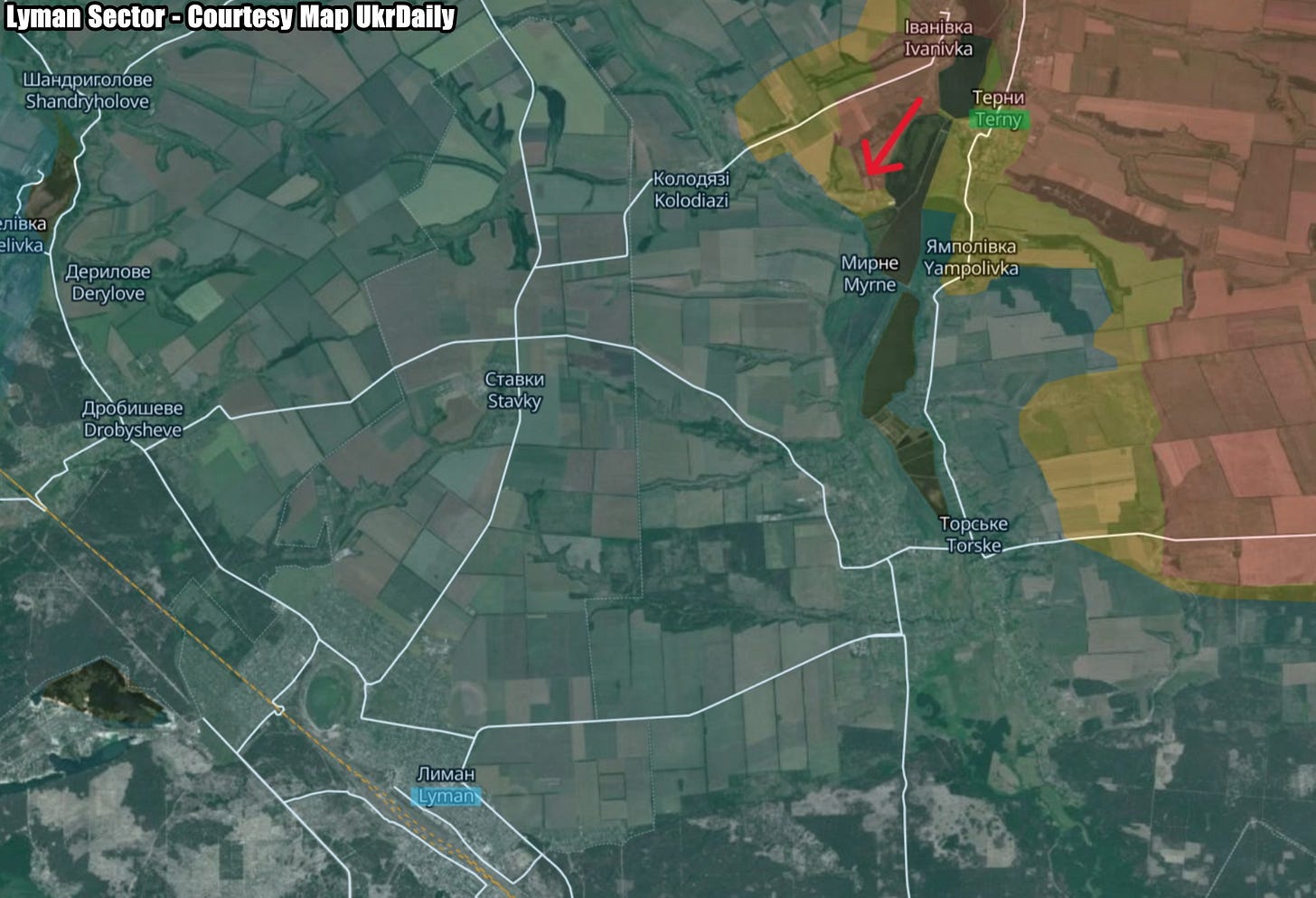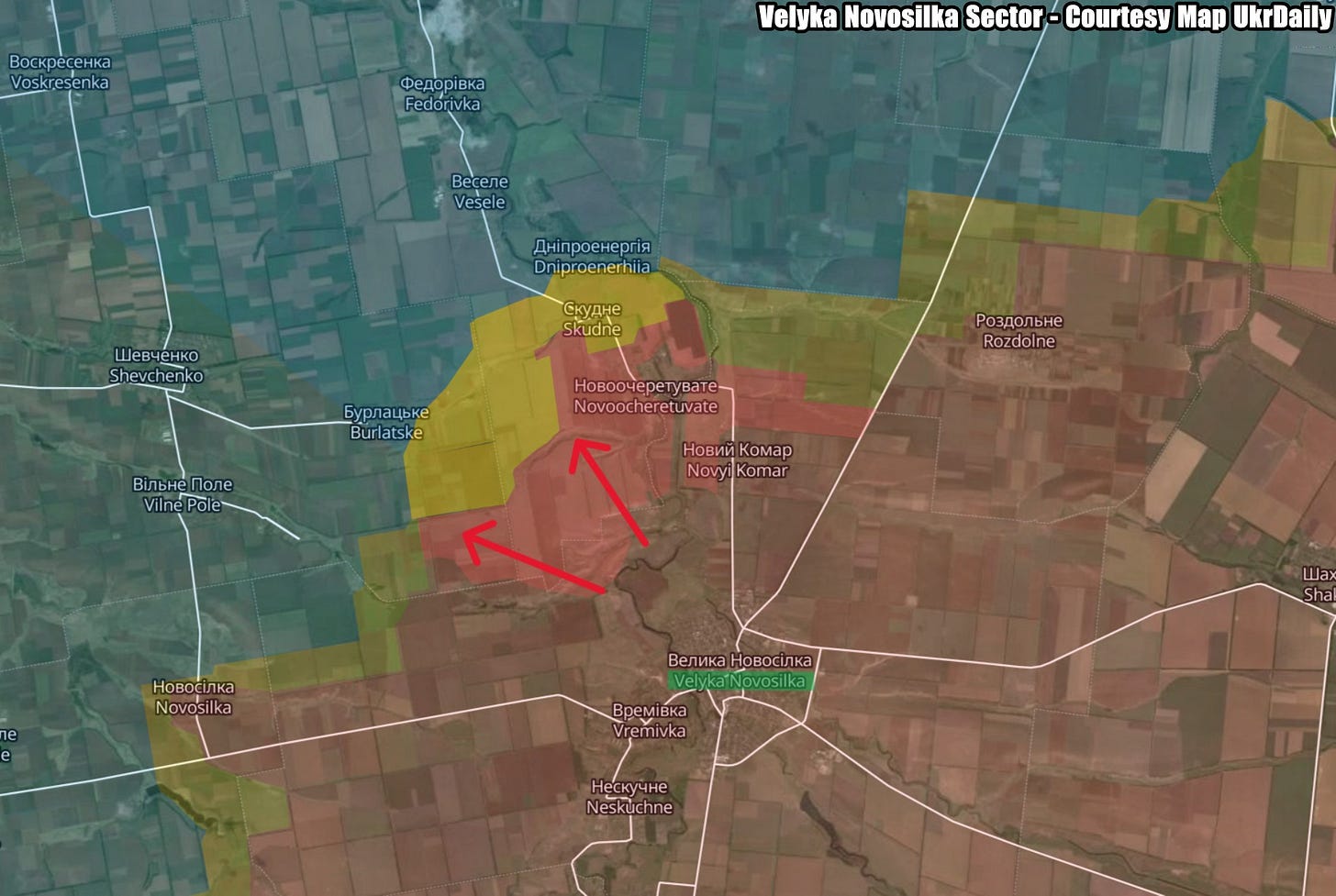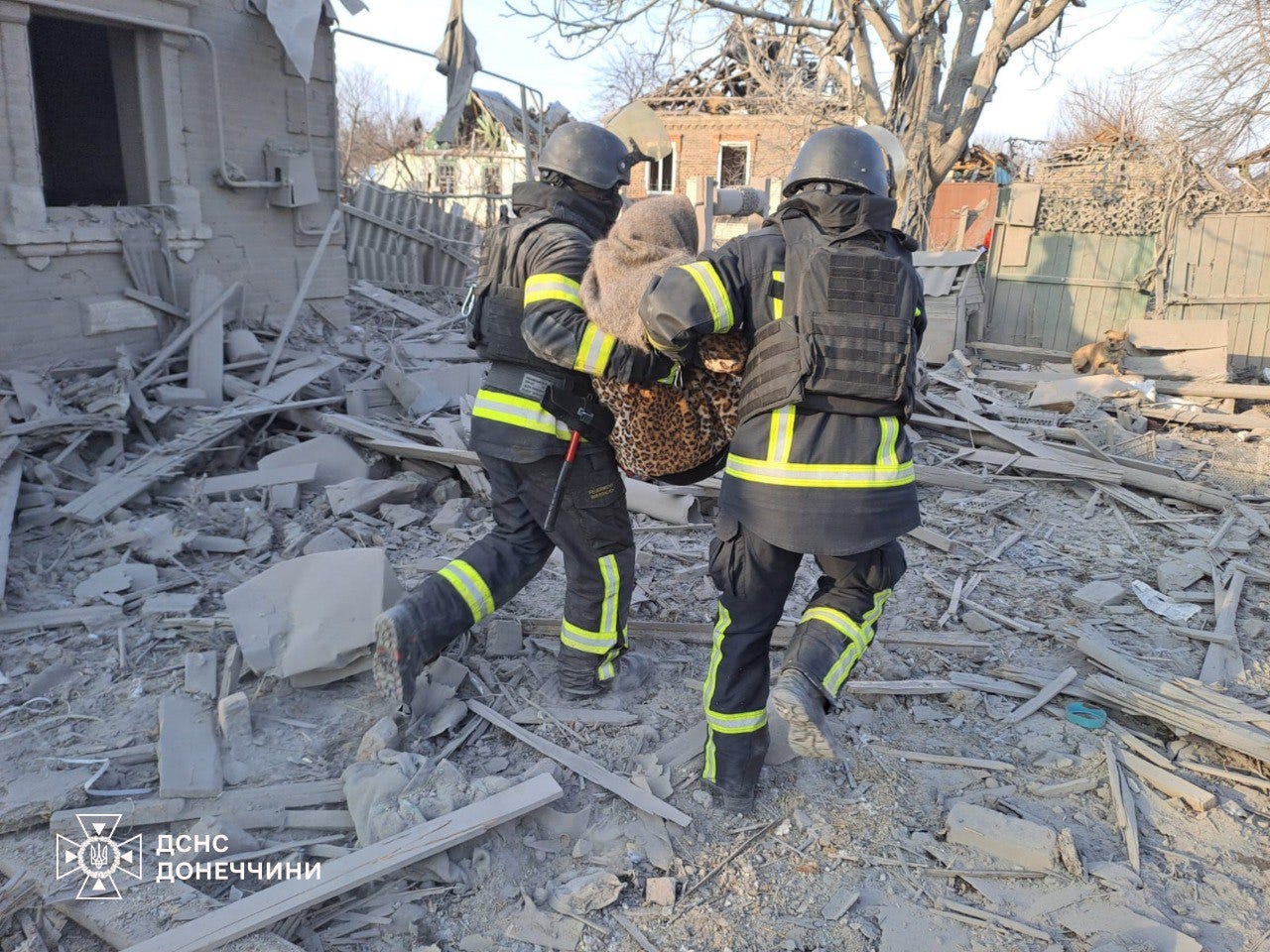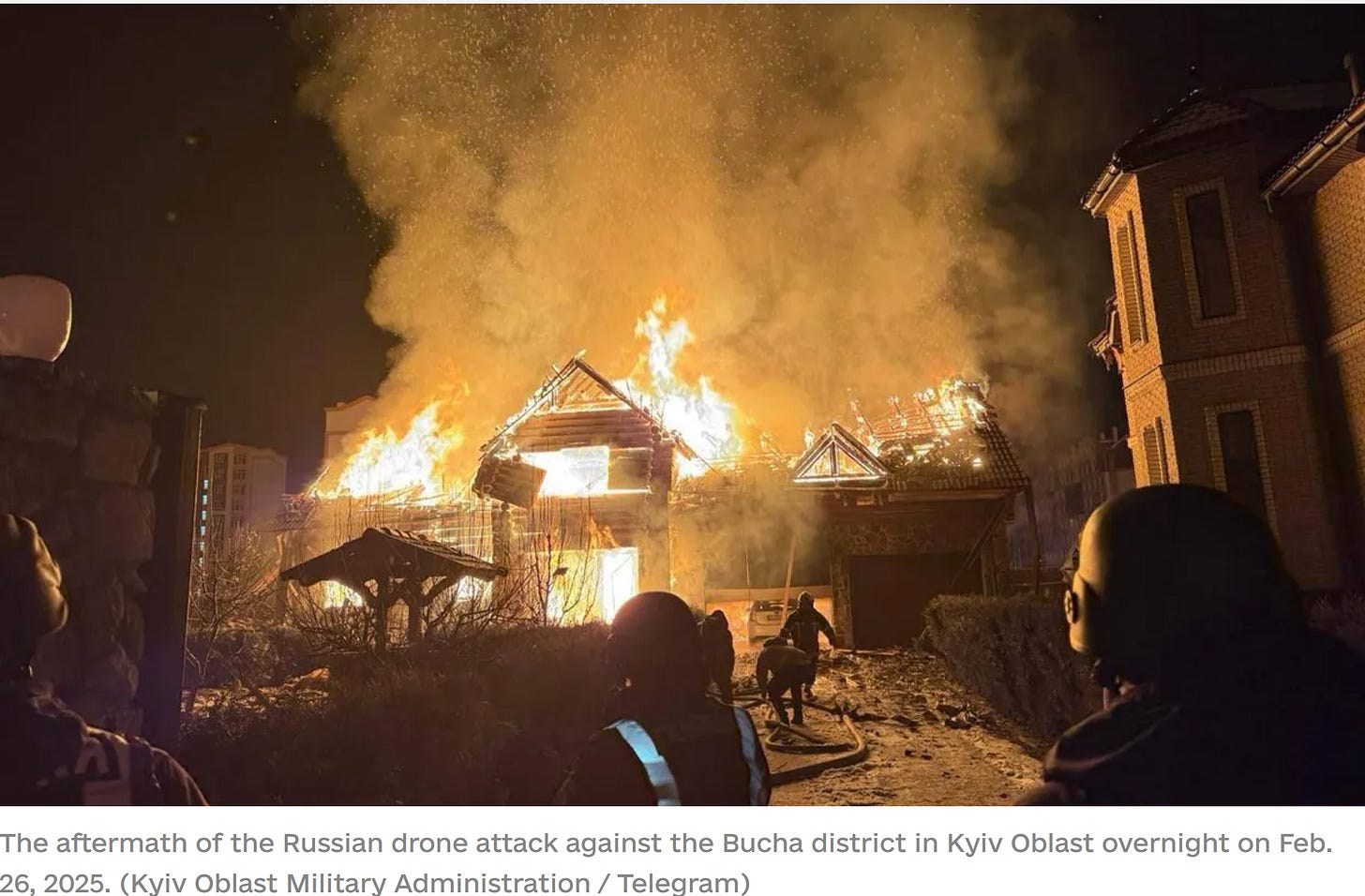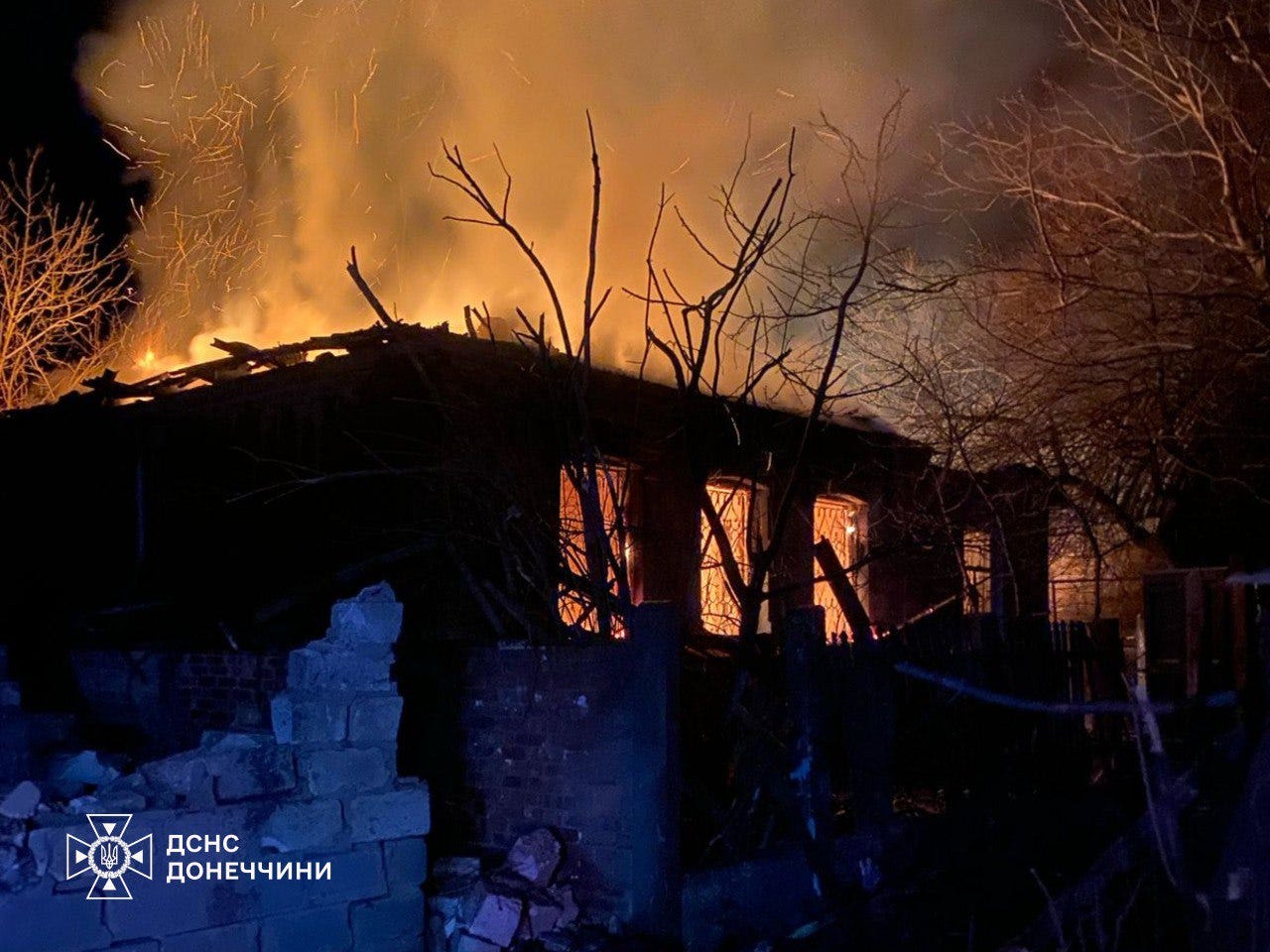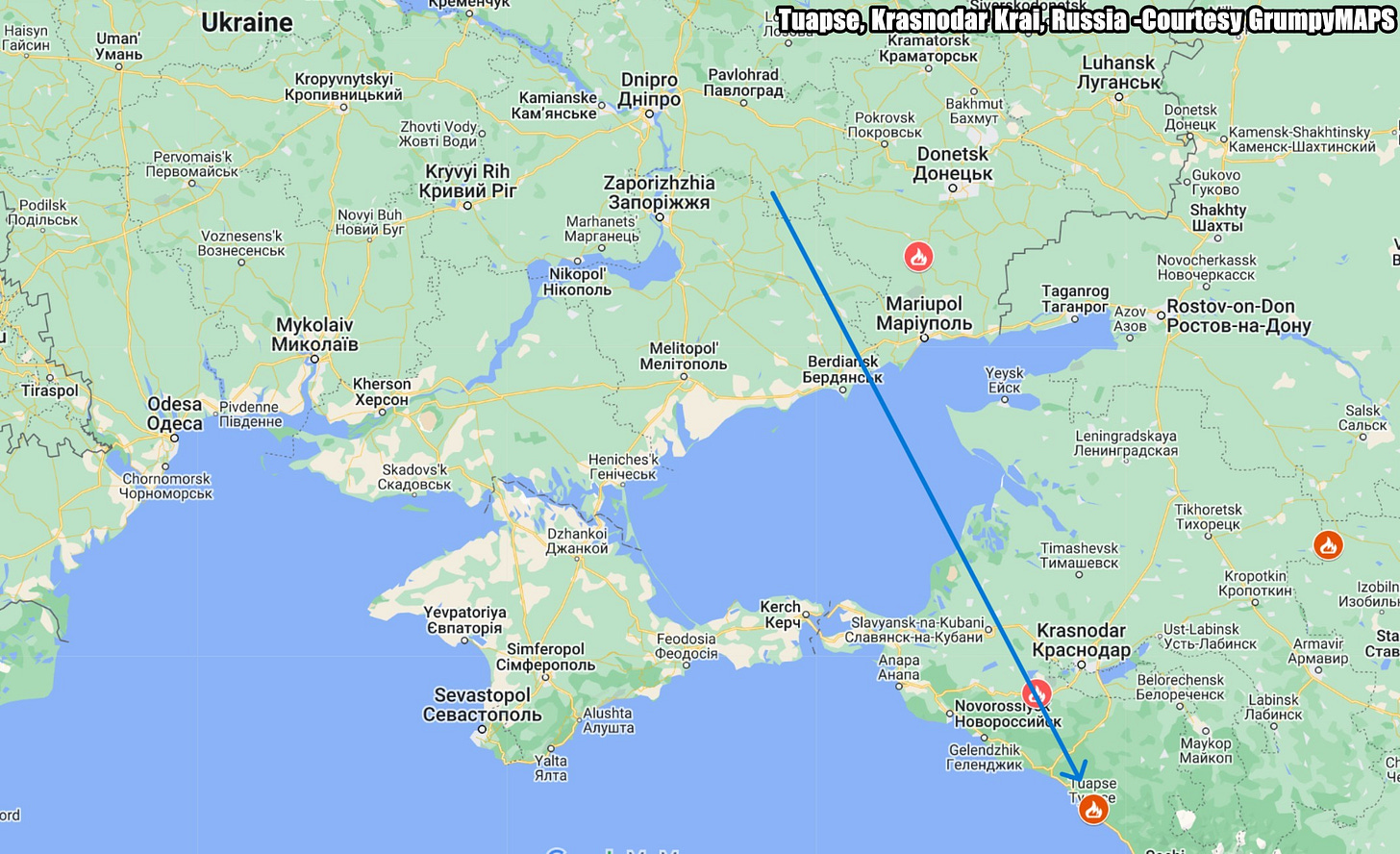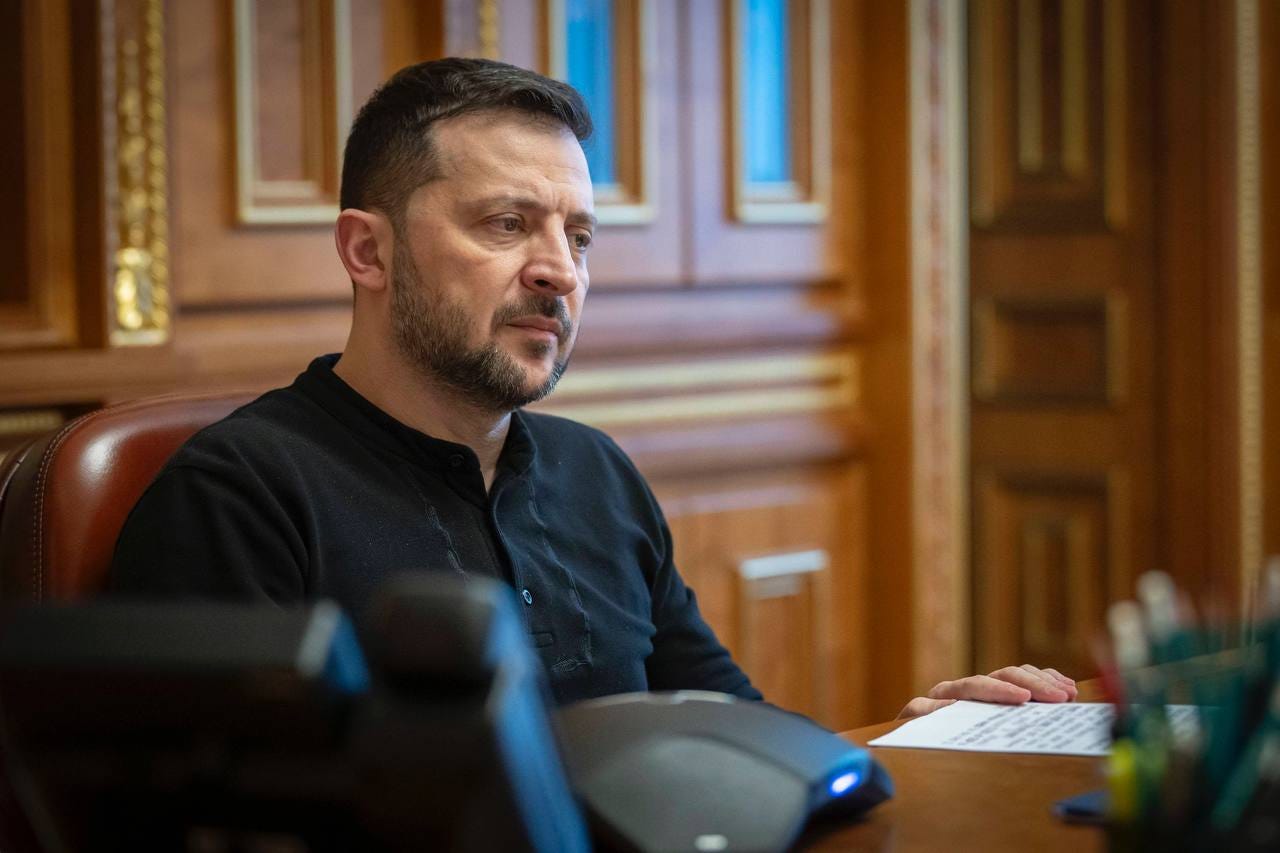Slava Ukraini! In early 2022 I began a Telegram channel aggregating news from a number of sources daily on the war in Ukraine. In June 2023 I began providing a daily draft for the Ukraine War Brief Podcast collecting news from over 70 sources daily, which formed the basis of the script. While the Podcast no longer exists I have continued to make this Brief available for my followers here on Substack for those who wish to keep up with the news from the war.
All the latest news on the Russo-Ukraine War 6 days per week
ALONG THE CONTACT LINE
GSAFU Morning Report
The General Staff of the Armed Forces of Ukraine in its Operational Information update at 08:00 on Feb 26 stated that day 1099 of the full-scale invasion of the Russian Federation against Ukraine had begun.
The situation on the line of combat remains tense in some sectors. Ukrainian defenders continue to actively counteract the Russian aggressor, causing them significant losses in personnel, equipment and technology. Exhausting the enemy along the entire front line and continuing to disrupt the plans of Russian occupiers to advance deeper into the territory of Ukraine.
During the past day, 98 combat engagements took place.
Over the past 24 hours, the enemy carried out 92 air strikes, used 3,439 drones and fired approximately 5,600 artillery shells across the positions of Ukrainian forces and civilians.
Air Force Daily Report
110 ENEMY UAVS SHOT DOWN, 66 DRONES FAILED TO REACH THEIR TARGETS (LOCATIONALLY LOST)
➖➖➖➖➖➖➖➖➖
On the night of February 26, 2025 (from 7:00 p.m. on February 25), the enemy attacked with 177 Shahed attack UAVs and simulator drones of various types from the directions: Orel, Bryansk, Kursk, Millerovo, Shatalovo, Primorsko-Akhtarsk - Russia.
The air attack was repelled by aviation, anti-aircraft missile troops, electronic warfare units, and mobile fire groups of the Air Force and Defense Forces of Ukraine.
As of 09:00, it was confirmed that 110 Shahed attack UAVs and drones of other types were shot down in Kharkiv, Poltava, Sumy, Kyiv, Chernihiv, Cherkasy, Kirovohrad, Mykolaiv, Kherson, and Dnipropetrovsk regions.
66 enemy drones-simulators - lost in location (without negative consequences).
As a result of the enemy attack, the Kyiv, Kharkiv, Kirovohrad, and Sumy regions suffered.
Combat Operations in the Kursk Sector, Russian Federation
The Institute for the Study of War (ISW), a US based think tank, in its Feb 25 Russian Offensive Campaign Assessment reported that Russian forces recently advanced in Kursk Oblast. Fighting continued northwest of Sudzha near Pogrebki, Orlovka, Novaya Sorochina, Staraya Sorochina, and Lebedevka.
Geolocated footage published on Feb 25 indicates that Russian forces recently advanced in central Pogrebki.
The Khortytsia operational-strategic group
(Responsible for the northeastern part of Ukraine. )
Kupyansk Sector: Ukrainian and Russian forces recently advanced in the Kupyansk direction. Russian forces conducted offensive operations north of Kupyansk near Dvorichna, east of Kupyansk near Petropavlivka, and southeast of Kupyansk near Stepova Novoselivka on Feb 24 and 25.
Geolocated footage published on Feb 25 indicates that Ukrainian forces recently advanced west of the P-79 Dvorichna-Kupyansk highway northeast of Zapadne (north of Kupyansk).
The Ukrainian General Staff published a map on Feb 25 indicating that Russian forces advanced northwest of Tabaivka (southeast of Kupyansk).
Lyman Sector: Russian forces recently advanced in the Lyman direction. Russian forces conducted offensive operations northeast of Lyman near Novolyubivka and Yampolivka and toward Zelena Dolyna, Nove, and Katerynivka and east of Lyman near Dibrova and in the Serebryanske forest area on Feb 24 and 25.
Assessed Russian advances: The Ukrainian General Staff published a map on Feb 25 indicating that Russian force advanced southwest of Terny (northeast of Lyman).
The Tavria operational-strategic group
(Responsible for the central-eastern and southeastern part of Ukraine.)
Pokrovsk Sector : Ukrainian troops have regained control of the village of Kotlyne, near Pokrovsk in Donetsk Oblast, the 25th Separate Airborne Brigade reported on Feb. 26.
The village of Kotlyne is located some 10 kilometers (6 miles) west of Pokrovsk. Kotlyne and Pokrovsk are connected by the T 0406 highway, which also leads to Dnipropetrovsk Oblast.
"Paratroopers of the 25th Separate Airborne Brigade of the Airborne Forces of the Ukrainian Armed Forces cleared the village of Kotlyne near Pokrovsk during the assault and recovery operations," the statement read.
Velyka Novosilka Sector: Russian forces recently advanced in the Velyka Novosilka direction. Russian forces continued ground attacks north of Velyka Novosilka near Skudne and Dniproenerhiya; northwest of Velyka Novosilka near Burlatske and Pryvilne; and west of Velyka Novosilka near Novopil on Feb 24 and 25.
Assessed Russian advances: The Ukrainian General Staff published a map on Feb 25 indicating that Russian forces advanced in fields north and west of Velyka Novosilka.
The Odesa operational-strategic group
(Responsible for Kherson, Qırım, (also known as Crimea) and the Black Sea.)
There have been no major changes to the combat environment since our last report.
TEMPORARILY OCCUPIED TERRITORIES
Nothing major to report.
THE HOME FRONT
Russian attacks across Ukraine kill 5, injure 36 over past day.
Russian attacks against Ukraine killed five civilians and injured 36 others over the past day, the Kyiv Independent reported citing regional authorities reported on Feb. 26.
Russian forces launched 177 drones from the Russian cities of Orel, Bryansk, Kursk, Shatalovo, Millerovo, and Primosk-Akhtarsk at Ukraine overnight, according to Ukraine's Air Force.
In Donetsk Oblast, Russian forces killed one civilian and injured 16 others in the Krasnotorka village in the Kramatorsk community. One person was also killed in the village of Yampil, while another was injured in the town of Kostiantynivka, Governor Vadym Filashkin said.
In Kherson Oblast, Russia targeted 36 settlements, including the regional center of Kherson, over the past day. As a result of the attacks, one person was killed, and eight other people were injured, Governor Oleksandr Prokudin reported.
On Feb. 26 morning, Russian forces also struck the village of Zelenivka with artillery, injuring a 72-year-old woman. She was hospitalized in a moderately severe condition.
In Kharkiv Oblast, a man was killed, and another was injured in a Russian attack with multiple rocket launchers against the villages of Bilyi Kolodiaz and Karaiichne.
Russia also targeted the village of Kutkivka with an FPV (first-person-view) drone, injuring a 55-year-old man. In the village of Zolochiv, two women suffered injuries as a result of glide bombs attacks, according to Governor Oleh Syniehubov.
In Kyiv Oblast, Russia carried out several strikes with drones, causing a fire in the Bucha district. Rescuers found a body while extinguishing the fire, the local military administration reported.
A woman and a man also suffered injuries in other settlements in Kyiv Oblast.
In Chernihiv Oblast, one person was injured in an attack against the village of Halahanivka, and another suffered injuries in an FPV strike on the village of Manukhivka, Operational Command "North" reported.
In Sumy Oblast, one civilian was injured in an FPV strike on the Bilopillia community, the local military administration reported.
In Zaporizhzhia Oblast, a 57-year-old man suffered injuries in an attack on the village of Stepnohirsk. Russian troops launched a total of 499 strikes on 12 settlements in Zaporizhzhia Oblast over the past day, according to the local military administration.
In Dnipropetrovsk Oblast, Russian forces hit a facility owned by DTEK, Ukraine's largest private energy company. The company did not specify which facility was affected. Power engineers are currently working on restoring its operation.
RUSSIAN WORLD
HUR confirms Ukrainian drone strike on Russia's Tuapse oil refinery.
Ukrainian drones successfully struck the Tuapse oil refinery in Russia's Krasnodar Krai region overnight on Feb. 26, the Kyiv Independent reported citing a source in Ukraine's military intelligence (HUR).
"According to intelligence sources, the attack on the facility resulted in at least 40 explosions and a fire, damaging oil refining equipment," the source said.
Earlier on Feb. 26, Russia's Defense Ministry said 128 Ukrainian drones had been downed over the country, 83 of them in Krasnodar Krai.
It did not report any damage or casualties but unverified videos posted to social media showed explosions in the area, including at a nearby seaport.
INTERNATIONAL NEWS
Ceasefire will not be possible without security guarantees for Ukraine - Zelenskyy
President Volodymyr Zelenskyy said during a press conference on Feb 26 that there will be no ceasefire in Ukraine without security guarantees for our country from the United States and its allies, Censor.NET reports.
"I will not agree to 10 cents of debt repayment in this agreement, otherwise it is a precedent. We are grateful and, as I said, in the next agreement, which this agreement opens up, where we can talk more substantively about security guarantees or specific amounts, how the fund will be managed, etc. We are ready to talk, if this is a condition, that further assistance to Ukraine will not be free, this is a new reality. Everyone understands the conditions we are in, we are at war. If I am told that we are continuing to help, we are giving you weapons worth 30 billion, you have to return something to us. They will say we will return it, because we will need this help," the president said.
Zelenskyy noted that between the first step (the framework agreement - ed.) and the second (the fund - ed.) step, Ukraine must understand where it stands in terms of partnership with the United States.
The administration of U.S. President Donald Trump has handed over to Ukraine an "improved" draft of the minerals agreement that "complies with Ukrainian law."
President Volodymyr Zelenskyy said that if the United States wants to see specific figures in the minerals agreement, then according to Ukrainian law, ratification by the Verkhovna Rada will be required.
On Feb 25, the Financial Times reports that Ukraine and the United States have agreed on the terms of the minerals agreement, and Kyiv is ready to sign the document.
On Feb 26, President Volodymyr Zelenskyy confirmed that Ukraine and the United States had agreed on a framework agreement on minerals.
Ukraine agrees minerals deal with US.
Kyiv has agreed terms with Washington on a minerals deal that Ukrainian officials hope will improve relations with the Trump administration and pave the way for a long-term US security commitment, the Financial Times reports.
Ukrainian officials said Kyiv was ready to sign the agreement on jointly developing its mineral resources, including oil and gas, after the US dropped demands for a right to $500bn in potential revenue from the deal.
The Ukrainian government is set to give its formal approval to the deal on Wednesday.
Although the text lacks explicit security guarantees, the officials argued they had negotiated far more favourable terms and depicted the deal as a way of broadening the relationship with the US to shore up Ukraine’s prospects after three years of war.
“The minerals agreement is only part of the picture. We have heard multiple times from the US administration that it’s part of a bigger picture,” Olha Stefanishyna, Ukraine’s deputy prime minister and justice minister who has led the negotiations, told the Financial Times on Tuesday.
A Ukrainian official with knowledge of the matter said president Volodymyr Zelenskyy was planning to travel to Washington on Friday to see Donald Trump and formalise the deal.
On Tuesday, the US president appeared to confirm his Ukrainian counterpart’s visit, saying: “I hear that [Zelenskyy is] coming on Friday. Certainly it’s OK with me if he’d like to.”
The original draft agreement’s highly onerous terms — which Trump presented as a means of Ukraine repaying the US for military and financial aid since Russia’s 2022 full-scale invasion — provoked outrage in Kyiv and other European capitals.
After Zelenskyy rejected that initial text last week, Trump called him a “dictator” and appeared to blame Ukraine for starting the war.
The final version of the agreement, dated February 25 and seen by the FT, would establish a fund into which Ukraine would contribute 50 per cent of proceeds from the “future monetisation” of state-owned mineral resources, including oil and gas, and associated logistics. The fund would also be able to invest in projects in Ukraine.
Ukraine has large underground deposits of critical minerals, including lithium, graphite, cobalt, titanium and rare earths such as scandium, that are essential for an array of industries from defence to electric vehicles.
The agreement excludes mineral resources that already contribute to Ukrainian government coffers, meaning it would not cover the existing activities of Naftogaz or Ukrnafta, Ukraine’s largest gas and oil producers.
However, it omits any reference to US security guarantees, which Kyiv had originally insisted on in return for agreeing to the deal.
It also leaves crucial questions such as the size of the US stake in the fund and the terms of “joint ownership” deals to be thrashed out in follow-up agreements.
The Trump administration’s initial sweeping proposal called for a reconstruction investment fund in which the US “maintains 100 per cent financial interest”.
Ukraine would contribute 50 per cent of the fund’s revenue from mineral resources extraction, including oil and gas and associated infrastructure, up to a maximum of $500bn.
Those terms, described as unacceptable by Ukrainian officials, have been removed from the final draft.
Ukrainian officials added the deal was just a “framework agreement” and that no revenue would change hands until the fund was in place, allowing them time to iron out any potential disagreements. Among the outstanding issues is to agree the jurisdiction of the agreement.
Just and lasting peace in Ukraine is impossible without security guarantees from NATO, - Meloni
Italian Prime Minister Giorgia Meloni said that peace in Ukraine is possible only if Kyiv is provided with security guarantees, in particular within NATO.
This is reported by ANSA with reference to Meloni's statement after a meeting with Swedish Prime Minister Ulf Kristersson in Rome, Censor.NET reports.
"Efforts must be made to lay the foundations for a just and lasting peace in Ukraine, which will come only when Kyiv is provided with adequate security guarantees to make sure that this does not happen again and that European countries that feel threatened can feel safe," Meloni said.
The Italian Prime Minister emphasized that these guarantees should be implemented within the framework of NATO, as she believes that this alliance is the most effective means to ensure a stable peace.
"I have always said and I believe that these security guarantees should be implemented within the Atlantic Alliance because I think that is the best framework to guarantee a peace that is neither fragile nor temporary, so that there is no longer a risk that Europe could be plunged back into the drama of war," Meloni said.
She also noted that alternative security options look more complicated and less effective.
"Other solutions, as I said, seem to me to be more complicated and, frankly, less effective," she concluded.
MILITARY & TECH
An end to US weapons shipments would be devastating, but not in the way you think.
Without U.S. military aid, Ukraine has enough weapons to keep fighting at its current pace until the summer, current and former Western officials said. After that, Kyiv could find itself short of ammunition and unable to use some of its most sophisticated weaponry. The Wall Street Journal reports.
Large weapons shipments the Biden administration sent or contracted for in its final months should be enough to enable the Ukrainians to keep fighting at their current rate at least until the middle of the year, said Celeste Wallander, a former senior Pentagon official. Some Ukrainian analysts say their country might be able to eke the weapons out even longer.
“We can endure maybe half a year or a year, in order to give Europe another year to start producing whatever munitions they can,” said Mykola Bielieskov, a senior analyst at Come Back Alive, a Ukrainian charity that has supplied drones to the military. “We might suffer some losses, maybe lose some territory. But we have no choice but to fight, despite the difficulties.”
An end to U.S. military aid is the worst-case scenario, said a senior aide to Zelensky, adding that it would mean Ukraine having to build up its military production and get more from Europeans.
Europe is preparing to try to make up the shortfall. In 2024, the European Union, the U.K. and Norway collectively supplied Ukraine with around $25 billion in military aid—more than the U.S. sent that year, according to European officials. The continent has substantially increased its production of artillery shells, and there are discussions for the EU to increase aid to $30 billion this year.
Since the start of Russia’s full-scale invasion of Ukraine, the U.S. has sent nearly $70 billion in military aid, according to Zelensky. That is more than all of Ukraine’s other Western allies combined, according to the Kiel Institute for the World Economy.
But Ukraine has also built its own formidable munitions industry, which now produces $30 billion a year in weaponry, according to the country’s minister of strategic industry, a sixfold increase from a year earlier. In 2024, the country produced around 1.5 million drones, which have become its primary form of defense along the front line, allowing Kyiv to hold off Russian assaults while taking minimal casualties. This year, officials say, they plan to produce 3,000 missiles and 30,000 long-range drones.
Overall, Ukraine currently builds or finances about 55% of its military hardware. The U.S. supplies around 20%, while Europe supplies 25%, according to one Western official.
But some U.S. supplies—including advanced air-defense systems, surface-to-surface ballistic missiles, navigation systems and long-range rocket artillery—will be effectively impossible to replace in the short term. Europe simply doesn’t make enough—or, in some cases, any.
Once those U.S. supplies run out, Ukraine’s ability to conduct longer-range strikes, and to protect its own rear positions, would suffer, officials and analysts said.
“Having a partner who supplies you with the highest quality military technologies, it’s by definition irreplaceable in some areas,” said Tomas Kopecny, the Czech governmental envoy for Ukraine’s reconstruction.
European leaders have held a series of meetings over the past week to plan how they can support Ukraine if the U.S. withdraws. The continent has also supplied some of Ukraine’s most effective weapons, including much of its modern artillery, medium-range air defense and cruise missiles. Still, analysts have questioned Europe’s ability to completely fill the gap created by lost U.S. supplies.
“While Europe could theoretically match the U.S. in spending, I don’t see them able to match the full breadth of weapons systems needed and, in certain critical categories such as air defense interceptors, there will quickly be a quantity problem,” said Oscar Jonsson, an academic at the Swedish Defense University.
The biggest challenge, according to analysts, would be the lack of American-made air defenses, which would leave Ukraine to decide which of its areas to protect and which to leave at risk. For example, only the U.S. produces Patriot air-defense systems, which can shoot down Russian ballistic missiles.
The loss of the U.S.-made Army Tactical Missile System, known as ATACMS, would also be a blow. Its range of up to 186 miles has made it particularly effective at striking Russian supply lines, though the Biden administration restricted the targets they could strike inside Russia.
Some analysts also questioned whether Ukraine would continue to have access to SpaceX’s Starlink internet service—a key battlefield advantage, which has been partly funded by the Pentagon. Elon Musk, the CEO of SpaceX, is a close ally of Trump.
Mykhailo Samus, director of the New Geopolitics Research Network, a Kyiv-based think tank, said it was possible that the U.S. could stop sending aid but still allow Europe to purchase American weapons on Ukraine’s behalf.
“It’s not really about aid—it’s about whether Trump will participate in the production of weapons for Ukraine,” he said. If not, “this will be a categorical blow to Ukraine and to Europe.”
Russia’s “precision” cruise missiles crash due to technical malfunctions.
On the morning of Feb 25, Ukraine’s Air Force reported that four Russian Tu-95MS “Bear-H” strategic bombers launched four cruise missiles from the vicinity of Engels, Saratov region, Russia. Defence Blog reports.
However, reports later confirmed that the missiles failed to reach their intended targets, instead falling in northern Ukraine’s Zhytomyr region due to technical malfunctions.
The State Emergency Service of Ukraine (DSNS) released footage showcasing the aftermath of a “high-precision” strike by a Russian Kh-101 cruise missile.
The missile struck a private residential area in Zhytomyr Oblast, causing destruction but reportedly failing to hit any military or strategic targets.
As a result of the Russian attack, neighboring Poland raised its air defenses. The Polish Armed Forces’ Operational Command confirmed that all available forces and assets, including ground-based air defense systems and radar reconnaissance units, were placed on high alert.
The incident highlights the continued use of long-range strategic bombers by Russia to target Ukrainian territory. However, the failure of these missiles to function as intended raises questions about the reliability of Russia’s cruise missile arsenal.
That’s it for today’s Brief folks if you would like to keep up with events in Ukraine daily please consider subscribing, it’s free!


